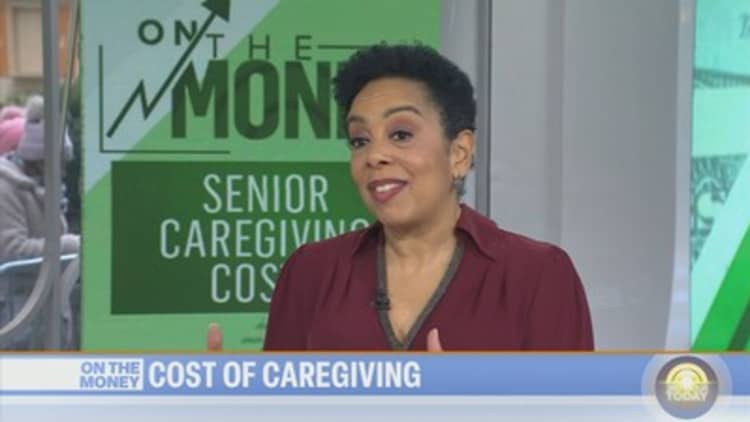
People living longer and in poor health has become a costly trend. An estimated 7 out of 10 people will require long-term care in their lifetime.
The median cost for a private room in a nursing home is more than $100,000 a year — and it’s $60,000 or more a year for a home health aide, according to a Genworth survey. The median cost for an assisted living facility is $54,000.
“In some cases, residents and their families don’t know their total costs until they receive their monthly bill,” Sen. Bob Casey, D-Pa., who chairs the Senate Special Committee on Aging, said in a hearing Thursday on costs and transparency in assisted living facilities.
“These substantial costs and hidden fees make it nearly impossible for older adults and their families to accurately budget for long-term care,” he added.
The alternative — caring for aging family members on your own — can also come with hefty expenses.
More from Personal Finance:
5 financial scams to watch out for in 2024
Tax season is here. What to know about itemizing, refunds and more
What to know about financial advice as policymakers debate rule changes
About 38 million family caregivers in the U.S. provide unpaid care valued at about $600 billion a year, according to a 2021 AARP report. That figure doesn’t include out-of-pocket costs related to looking after a loved one.
“The average family caregiver spends about 26% of their income [on caregiving activities], which nationally averages out to about $7,000,” said AARP’s family and caregiving expert Amy Goyer, referring to the 2021 AARP analysis. “Some spend much more and some spend much less,” depending on their location and the care they provide, she added.
Knowing a few key terms can help you understand the services an aging parent or relative may need — and plan ahead for how to afford them.
Here are five essential terms you should know:
Activities of daily living
Long-term care involves various services to meet a person’s health or personal care needs when they can no longer perform everyday activities independently and require assistance. These everyday tasks are often called “activities of daily living” — and can include bathing, dressing, eating, taking medications, using the bathroom and transferring from standing to a chair or bed.
Continuous care retirement communities
There are many choices for where your loved one can live as they grow older and receive long-term care when needed. “Aging in place” while living at home or going to a nursing home are not the only two options.
“Not everyone is going to qualify for nursing home care — not everybody needs it,” said Abbe Udochi, founder and CEO of Concierge Healthcare Consulting, a New York-based geriatric care management practice. “Nursing home care is like living in a hospital … you’re going to find people with serious functional issues and cognitive issues.”
Maskot | Maskot | Getty Images
Continuous care retirement communities run the gamut and can be an alternative to aging in one facility or group of facilities. “The idea is to have these all on the same campus so that you can go between the levels of care as you need,” said AARP’s Goyer.
- Starting with “independent living,” older adults can live in a house, condo or apartment and receive several services — two or three meals daily, housekeeping and/or laundry services.
- When they need more care, they can move to “assisted living,” where they may get help with some activities of daily living, such as bathing, dressing or eating. The level of assistance can vary and costs rise as more help is needed.
- The highest level of care is “skilled nursing care” for those who are chronically ill or disabled and can no longer care for themselves. This could be a particular unit or nursing home within the community. Some communities also offer “memory care” units or facilities for residents with dementia or Alzheimer’s disease, providing more secure and specialized care.
Within these communities, costs can vary greatly depending on the type of care and geographic location.
Some continuous care retirement communities offer a monthly rental option. Others require residents to “buy in” by paying a sizeable entrance fee — more than $442,000 on average, according to the National Investment Center for Seniors Housing & Care. Then they refund a percentage of that fee when the resident leaves the community. Monthly fees may also be charged.
Within these communities, average monthly rent for independent living is about $3,900, assisted living costs about $6,700 a month, and memory care costs about $8,400 a month, according to the National Investment Center.
Medicare and Medicaid
When it comes to paying for long-term care services and facilities, many people believe that Medicare will cover the cost, as long as you’re 65 and older and have that federal health insurance. They’re wrong.
Medicare provides very limited coverage for long-term care — and it is vital to check your plan to find out what, if any, services may be covered. Some Medicare Advantage plans may cover specialized care, including skilled nursing, respite and hospice care.
Medicaid pays for most long-term care services — but only for people with low incomes and little savings.
Long-term care insurance
Depending on the plan, long-term care insurance pays for services from at-home care to assisted living, memory care, skilled nursing care, and hospice.
“There are long-term care insurance policies that will pay for care once you are unable to perform two of six daily living activities without assistance, such as bathing or showering, dressing, getting in and out of bed or a chair, walking, using the toilet and eating,” said certified financial planner Ivory Johnson, founder of Delancey Wealth Management in Washington, D.C.
Long-term care insurance may have annual premiums that increase over time or may be included as a rider to a life insurance policy. “The latter has a death benefit if you never need long-term care, premiums that cannot be increased, and is more expensive,” said Johnson, a member of the CNBC FA Council.
According to data from the American Association for Long-Term Care Insurance, the average annual premiums for policies with a 3% growth rate in 2021 ranged from $2,220 at age 55 for a single man to $5,265 at age 65 for a single woman, if both had some health issues. Couples paid less per person.
Employers are increasingly offering long-term care insurance as a workplace benefit. It’s worth checking to see the workplace benefits your employer may offer to help with caregiving for an older spouse, parent or relative.
Respite care
“It really simply just means a break from caregiving,” Goyer said. “And it’s one of the most crucial things that caregivers need.”
Asking friends and family for caregiving help is often the first step but may be unrealistic depending on their responsibilities. Other options for respite care include finding an adult day care center, paying for professional help in the home, or moving your loved one to an assisted care residence for a short stay.
Some long-term care insurance plans provide coverage for respite care, but there may be other places to get free or low-cost assistance. Check your loved one’s Medicare plan. Military veterans may be able to get resources from the Department of Veteran Affairs to cover the cost of respite care.
The U.S. Administration on Aging’s Eldercare Locator can connect you with a local Area Agency on Aging that can offer in-home respite care support, including sitter service and preparing meals. The ARCH National Respite Network can also help you find local respite providers.
Coverage for respite care can vary depending on your Medicare, Medicaid or health insurance plan. Ask your provider. And ask your employer. Some companies may offer paid time off for workers to provide respite care or senior caregiving.
If your employer offers a dependent care flexible spending account, you can typically put in up to $5,000 in this account through payroll deductions, to use for respite care and other elder care costs, as long as you claim the qualifying family member as a dependent on your tax return.
Employers may also offer senior caregiving support by helping employees navigate Medicare and Medicaid, explore in-home and out-of-home care options, and connect them to caregiving resources.
SIGN UP: Money 101 is an 8-week learning course to financial freedom, delivered weekly to your inbox.
— CNBC’s Stephanie Dhue contributed to this report.

